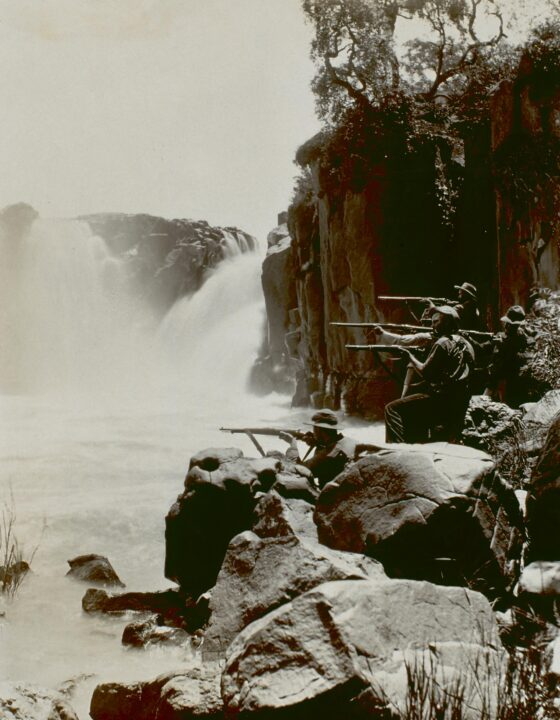
The First Anglo-Boer War – also known as the First Transvaal War of Independence – was a conflict from 1880 to 1881 between the British colonizers and the Boers from the Transvaal Republic.
The second conflict, from 1899 to 1902, is known as the South African War.
Look closely at the photograph below from the South African War. Do you think it’s staged? Why or why not?

A matter of outposts, Boer snipers exchanging shots with British outposts below Tugela Falls, Reginald Sheppard. 1900. Catalogue ref: COPY 1/450/476
Reginald Sheppard was in the Boer Commando in Pretoria [guerrilla military unit in South Africa.] He was a professional photographer who used his camera in the conflict. Some of his photographs, like the one above, were posed.
How can we tell?
- The snipers look posed because they are all firing in the same manner with their rifles, and at the same height, which does not seem likely.
- The men are not in safe or strategic positions. They are highly exposed – standing would have made them easy targets. Snipers are marksmen who tend to move undercover and at night. They often act in support roles in a concealed place, or outpost with a clear view. They stay at a distance from the main body of an army to protect it from surprise attacks. This photograph is not convincing as a war photograph taken in the field during this type of action.
- The framing appears overly ‘scenic’ with the waterfall and river as backdrop. It looks too peaceful and does not capture the grim realities of war.
General points on posed or staged photographs
If you are trying to work out if a photograph has been staged:
- Pay attention to the light it contains. Do the shadows and reflections look natural?
- Try and assess the perspective and proportions of the image. Does the image contain any repeated identical patterns that could have been added into it?
- How natural is the colour and tone of the photograph?
- Carry out a reverse image search if possible.
Finally, it is important to remember that early photographs from the 1840s and 1850s required very long exposure times, so people had to sit still for very long time in formal positions. The invention of the Box Brownie camera and other portable devices in the 1880s and 1890s meant that the subjects for photography expanded to capture a broader range of people, places and subjects.
Questions
- What makes this an artistically framed photograph? [Explain how light, shade, angle, scale, and line are used.]
- What makes it difficult to believe that this photograph was taken during an exchange of sniper fire?
- Where would the photographer have been standing with a tripod to take this photograph?
- What would make this photograph more convincing as a piece of evidence for the Boer war?
- If we didn’t have background knowledge of the situation in which this photograph was taken, what would be its value?
- How do you interpret the meaning of the caption of the photograph?